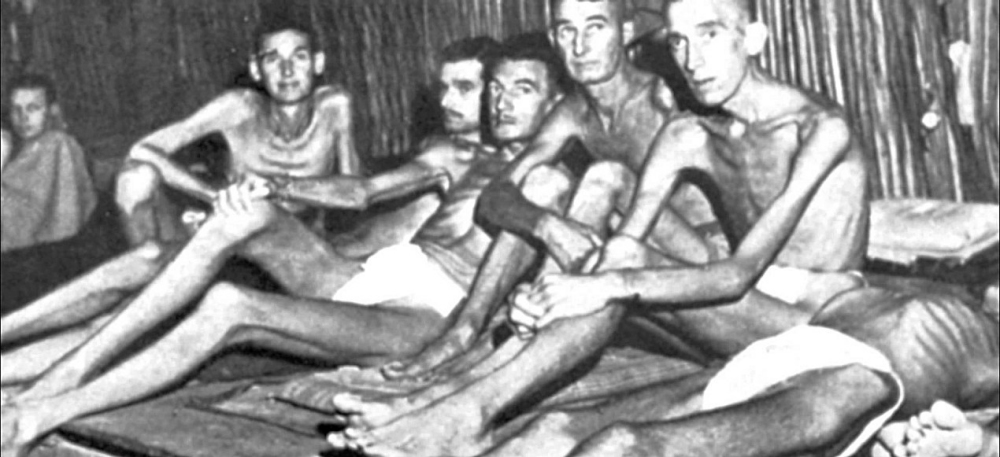
The following article appeared on December 22, 2015 in Hasselt Historiael, the quarterly magazine of the Historical Society of Hasselt. View an impression below or download the PDF (Dutch only).
Mars, the Bringer of War (Gustav Holst)
 From elite soldier to prisoner of war under the Japanese (1935-1943)
From elite soldier to prisoner of war under the Japanese (1935-1943)
Gerrit Visscher deported to the jungle camps of Siam
(All books and combat reports referred to are written in Dutch, except The Death Railway - A brief history of the Thailand-Burma Railway by Rod Beatty)
The military life of Gerrit Visscher (born Hasselt, the Netherlands, July 11, 1916) can roughly be divided into the following periods:
1. The period of employment at the Royal Dutch East Indian Army (KNIL) and the encampment at Semarang, Central Java.
2. The march to and combat operations around Bandung (February 22 to March 8, 1942).
3. The surrender of the KNIL on March 8, 1942 and the captivity on Java.
4. Deportation to and work at the Burma railway in Thailand, formerly known as Siam.
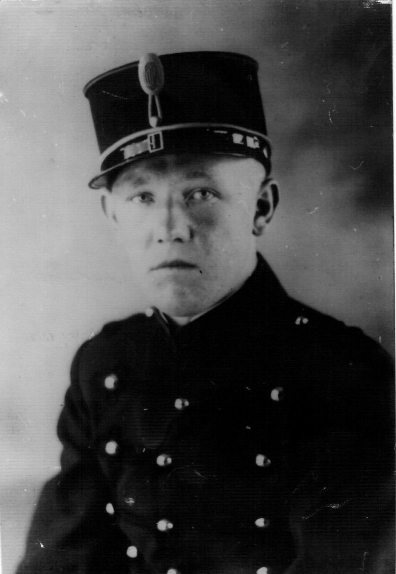 The period of employment at the Royal Dutch East Indian Army (KNIL) and the encampment at Semarang (town) on Central Java.
The period of employment at the Royal Dutch East Indian Army (KNIL) and the encampment at Semarang (town) on Central Java.
Perhaps under pressure of the economic crisis and high unemployment during the 30's of the 20th century, which would doubtlessly have affected the citizens of Hasselt as well, Gerrit Visscher decided, at the age of 18, to join the Royal Dutch East Indian Army. At that time, there was a lot of advertising for the KNIL, found in newspapers and on posters. Signing up for a number of years as a professional soldier, after all, did bring in a reasonable start-up premium, although on the other hand pay was quite sober. In 1938, for instance, you earned as a soldier 2nd Class 0.75 to 1 guilder per day. This was spending money. "Food, clothing, housing, doctor and medicines are free". In addition to bonuses, pay and favorable benefits, the profession of a KNIL soldier gave a lot of status; after all, you were a member of an elite corps.
The recruitment agency of the KNIL, the Colonial Reserve Corps, was up until the beginning of the 20th century far from an elite corps but rather a kind of foreign legion, which had a very bad reputation. The Colonial Reserve Corps, which was located at the infamous Harderwijk, was also called "sewer of Europe". In the decades that followed, efforts were made to create a decent but strict recruitment office, eliminating adventurers and criminals. In 1935, the first year of Gerrits enlistment, this depot had become largely operational and had transformed from a "motley crew" to an elite corps.
After a rigorous inspection, Gerrit began a short, intensive training started at the Prins Hendrik barracks in the garrison city of Nijmegen at the Colonial Reserve Corps (the building still exists and is now a refugee center). On April 18, 1935 Gerrit made a commitment to "the Overseas military service, both in and outside Europe" for a period of 3 years. On July 24, though, the contract was changed into a commitment for a period of 5 years. Gerrit now belonged to a corps where only 10% of the candidates finally got access to and was found suitable formally on July 30 to be sent out to the Dutch East Indies. The premium was 100 guilders, almost 1,000 euros now. He finally got two weeks leave, which could be used to say goodbye to the family. (Anybody who is interested in the Colonial Reserve Corps should read the book The Forgotten Corps. The History of the Colonial Reserve by author Clemens Verhoeven. The book contains many photographs, also from the time that Gerrit was in training).
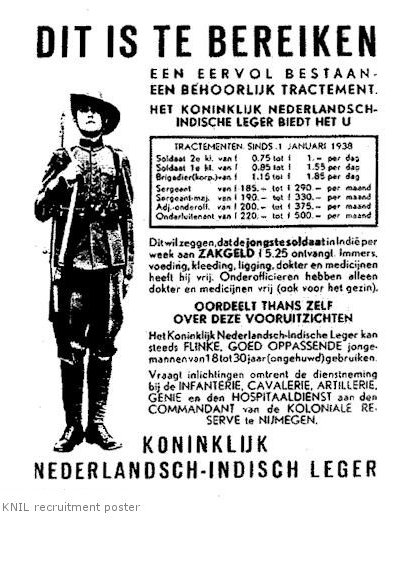
On August 14, 1935 Gerrit embarked on the mail ship ms Baloeran in Rotterdam. This ship of shipping company Rotterdamse Lloyd sailed on the line Rotterdam-Batavia and transported mail, civilians and military. Departure and arrival dates and complete passenger lists at that time were frequently read between the "ships messages" in both Dutch and Dutch East Indian newspapers. Soerabaijasch Handelsblad of August 14 for example, states: "Detachment to the Dutch East Indies. With the ms Baloeran that departs today from Rotterdam, a detachment complementary forces of the Colonial Reserve is sent off to the Dutch East Indies at the strength of 5 officers and 34 military below that rank. Commander of the detachment is 1st lieutenant of the Royal Dutch East Indies Army Ch. L. Klein ". Unfortunately, in the passengers list the soldiers were not mentioned by name; they only mentioned "a detachment complementary forces of the Colonial Reserve." Anyway, Gerrit made part of this detachment, which by the way sailed with the lowest, fourth class. Departure and arrival dates of intermediate ports were also reported and thus we get a pretty good picture of the 23rd trip of the Baloeran. The ship made the following cities: Southampton (16/8), Lisbon (19/8), Tangier, Gibraltar (20/8), Marseille (23/8), Port Said (27/8), Suez (28 / 8), Colombo (5/9), Sabang, Belawan-Deli (9/9), Singapore (10/9), Batavia (12/9). So the journey took at that time nearly a month. On September 14 disembarkation followed at the port of Batavia, Tandjong Priok that Gerrit would see seven years later, but then as a prisoner of war and on his way to the Burma railway. The Baloeran was confiscated by the Germans in a later stage of the war and converted into a hospital ship, the Strassburg. In 1943, she ran on a mine and now lies at the bottom of the North Sea near IJmuiden.
Gerrit was a fusilier (an infantryman armed with a rifle) at the 1st European Company of the 5th Infantry Battalion, in military circles referred to as '1-Inf V', and encamped at Semarang on Central Java at the camp of Karangasem (not to be confused with the regency of Karangasem on Bali), which was established in 1918. Unfortunately, facts about Gerrits military time in Semarang are unknown. The family in Hasselt ever received mail from the East Indies, but these letters have proved to be untraceable. After the declaration of war on December 8, 1941 by the Netherlands to Japan (following the attack on Pearl Harbor) it remained relatively quiet in Semarang for more than two months. What actually did happen is to be read the book Semarang, image of a city from author B. Brommer.
The march to and combat operations around Bandung (February 22 to March 8, 1942)
Through the eye of the needle - Combat operations of the 1st European company
End of February 1942 everything changed. Japan attacked Java in three places and panic struck. On February 22, the entire 4th Infantry Regiment, which includes the 5th Infantry Battalion, moved from Semarang on Central Java to the Bandung plateau on West Java to provide support to the defense there and was now known as Group Bandung. The 5th Infantry battalion consisted of four companies of every 150 men. The first was the European company (Gerrits company). The second company consisted of Timorese, the third of Sundanese and the fourth was a machine-gun company. So on February 22, Gerrit left Semarang and arrived in the evening of February 24 at or around Bandung. The fighting had erupted on Java and the Japanese pulled ever further. Until the surrender on March 8, Gerrits company, which operated under 1st Lieutenant Faber, took various combat positions. Late February at Tjirandjang, near the river Tjisokan. On February, 28 it went to Bandung. Then they went on to Soebang, north of Bandung, where the company arrived March 3rd to prepare for an attack that later failed completely, and from March 4 to March 5 it went southward again to Lembang towards Bandung, actually fleeing from the advancing Japanese. On March 5, 1-Inf. V, to support the troops at the Tjiaterstelling, was directed to the north again. This was a tricky situation, because Gerrit found himself put in the front line, which was under fire continuously from Japanese tanks and aircraft and bullets must have flown around. But the battle at Tjiater was lost and withdrawal was necessary. Dramatic low around this defeat was a mass execution that took place there on March 6; during the retreat about 72 soldiers were trapped by the Japanese. The soldiers were tied up with their leg bandages and then executed. Among them, 39 men of one of the three sections of the 1st Company. Gerrit did not belong to that section, because his group made a detour during the withdrawal in the direction of Bandung. After two days of walking, Gerrits section, that consisted of only 25 men, reached Bandung in an exhausted state and were immediately made prisoner. The rest of the battalion arrived in separate groups. The 1st Company had lost 50 men in a few days time. 1st Lieutenant Faber, who had shown heroism and thereby possibly had saved lives, later received the Military William Order 4th class for his actions.
For a detailed and penetrating account of the military operations around Bandung I refer to the book The Japanese attack on Java by the authors J.J. Nortier, P. Kruijt and P.M.H. Groen and to the eyewitness account of A. Schouten, 2nd Lieutenant of the Infantry and one of the three section commanders: Report of the action of the first European company of the fifth infantry battalion at Semarang from February 22, 1942 until March 6, 1942.
Impression of the combat operations late February and early March 1942 in different areas of Java.
The surrender of the KNIL on March 8, 1942 and the captivity on Java.
The KNIL, which was not a true fighting army, was unable to withstand the fanatical Japanese and capitulated on March 8. Soldiers of the KNIL were taken prisoner and interned in many camps on Java. Gerrit was interned in the POW camp of the 1st Depot Battalion at Bandung.
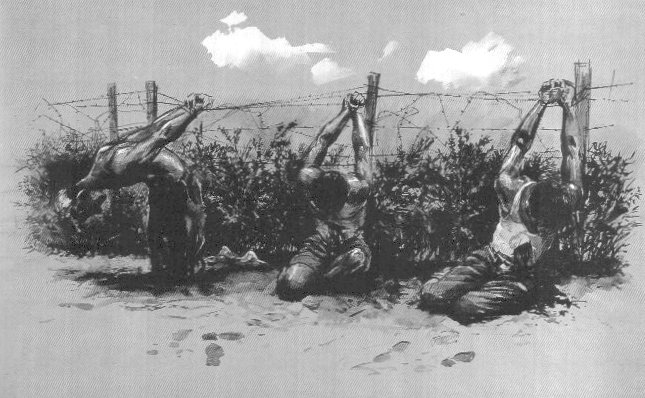
Conditions in the POW camp of the 15th Infantry Battalion, which the 1st Depot Battalion was part of. Three with bayonets
executed prisoners of war after a failed escape attempt. Drawing by eyewitness and prisoner of war Charles Burki.
Source: Bandoeng. Beeld van een stad.
During the months, there were many POW transports on Java, often in preparation for transport to Japan, Burma and Siam. The Burma railway had already been under construction and there was a regular flow of new workers needed since May 1942. Around June 18, 1942 there was a large (blinded) rail transport with prisoners of war takes place from Bandung to two camps at Tjilatjap on eastern Java. Gerrit was aboard this transport. At Tjilatjap there was an infantry and an artillery camp. The prisoners who came from Bandung on June 18, were divided into two camps. But only from the artillery camp soldiers departed to Batavia (Gerrits next stop). In both camps ruled a reign of terror. Beatings and humiliation were daily routines. Gerrit has stayed here for a long time. After six months, on January 4, 1943 to be exact, he departs from Tjilatjap and arrives one day later at the camp of the 10th battalion, a transit camp in downtown Batavia. A few days later he would arrive in Tandjong Priok, the port of Batavia, where he arrived seven years earlier as a proud professional soldier for the first time.
Deportation to and work at the Burma railway in Thailand, formerly known as Siam.
Deportation to the jungle hell of Siam
On January 15, 1943 3188 prisoners of war boarded the Dutch ship Van Waerwijck. The group was designated Java Party 9, the ninth shipment that departed from Java. The ship was now in Japanese hands and was called Harugiku Maru. Among the prisoners was Gerrit Visscher. The conditions on the ship were almost indescribable. In the ships hold, the air was very hot and unbearable. The prisoners, who were crammed were seasick and vomited before they could come out. After two days, the first dysentery cases occurred, and obviously that without sanitation. Furthermore, Japanese transports, because they were not made known that prisoners of war were on board, were regularly attacked by Allied aircraft and also sunk. Here many prisoners of war perished. The journey of the Harugiku Maru 2 (the second transport of the ship), however, passed off remarkably quiet. January 18 the transport arrived in Singapore and a day later the soldiers were imprisoned in the huge encampment, called Changi. The prisoners situation was relatively calm for a moment, but January 29 Gerrit left with rail transport 43 along with 624 other inmates for a 5-day, hellish ride towards Ban Pong, Siam. The wagons were crammed with every 25 to 30 men. They could only sit with bent knees. Even Gerrit, who was 5' 5" feet tall, will have had problems with this. At night it was freezing, during the day burning hot. Because the carriages were of iron, you couldn't lean against the walls. People who became ill had a problem and those who had to relieve themselves, whether because of dysentery , were hanged outside the moving train by fellow prisoners. Only occasionally the train stopped to get food distributed. For a few it was even possible to buy some food from the local population with private money, insofar as they had. After 5 days, on February 3, the hellish ride ended at Ban Pong. Ban Pong was also the starting point for a subsequent transport, now towards the jungle camps of the 415 kilometers long railroad between Nong Pladuk in Siam and Thanbyauzayat in Burma. The first prisoners of war were transported by truck to the various jungle camps. Soldiers who were transported later had bad luck; the roads were rutted by earlier shipments, so they had to walk the same distance. They had often marched consecutive nights. Gerrit belonged to one of the first groups and so he could count himself "lucky".
The route that has been covered is based primarily on witness accounts of former prisoners. These reports have been intensively analyzed by researcher Henk Beekhuis and published on his website, an incredible work (see www.japansekrijgsgevangenkampen.nl). We get a fairly clear picture of the prisoners of war shipments and on this basis we can assume with reasonable certainty that Gerrit arrived the same day (so February 3) at the transit camp Tarsao at 130 km. from Nong Pladuk and that he was transported by truck to camp Kinsayok on February 5 at 171 km. Then to be followed by a hike to camp Rintin at 181 km., also called Deadman's Camp or "camp of death" and where they worked at the railroad. Conditions in the camps are beyond any imagination, and are described in many reports by former prisoners of war who survived the railway (see bibliography). In any case, many were beaten by the Japanese and many people fell ill from exhaustion and vitamin deficiency (avitaminosis) and started suffering from highly contagious cholera or dysentery, tropical ulcers, beriberi or malaria. The number of deaths was uncountable. These conditions can be called "hell on earth". Rintin was lifted after three months because of a dysentery epidemic. Where Gerrit was between the closing of the camp and November, the month of death, is not entirely clear. The chances are reasonable that he has gone up to a higher camp, eg. Hindato at 198 km. or Brankasi at 208 km. of the starting point of the railroad.
Illness and death
The Japanese internment card mentions that Gerrit became ill on September 20. He suffered from malaria. Details of his illness and its progress are not known. He died on Saturday, November 12, 1943 at 11:30 am at the Aerodrome Camp in Kanchanaburi (a hospital camp 50 km. from Nong Pladuk) and was buried immediately in grave 231A near the Kanchanaburi Base Hospital BG. No. 1. Later, he was reburied at the cemetery at Kanchanaburi, grave 7.B.38. Not until July 29, 1945 the following message on his death was received through the International Red Cross in Geneva from the Japanese army in Tokyo: "Deceased on 12-11-'43 in the Thai camp Netherland prisoner fus visscher gerrit 91138 malaria". Gerrits father, Johannes Visscher, who lived in the Kalverstraat, got an on November 22, 1945 dated letter with notification of his death handed over by the mayor of Hasselt. So two years later! It is harsh, that the railroad was already finished on the day he died and only maintenance was done. According to a statement of Bronbeek the total number of victims of the Burma railway was nearly 200,000, of which nearly 13,000 prisoners of war. Among these were 3,098 Dutch prisoners of war. The majority consisted of Asian forced laborers, the so-called Romushas (180,000). It is said that under each sleeper of the railroad lies one dead man.
After the war, many former prisoners, after being recovered, returned to the Dutch East Indies to take part in the Indonesian war of independence and the police actions. At least, Gerrit Visscher didn't have to take part in thát.
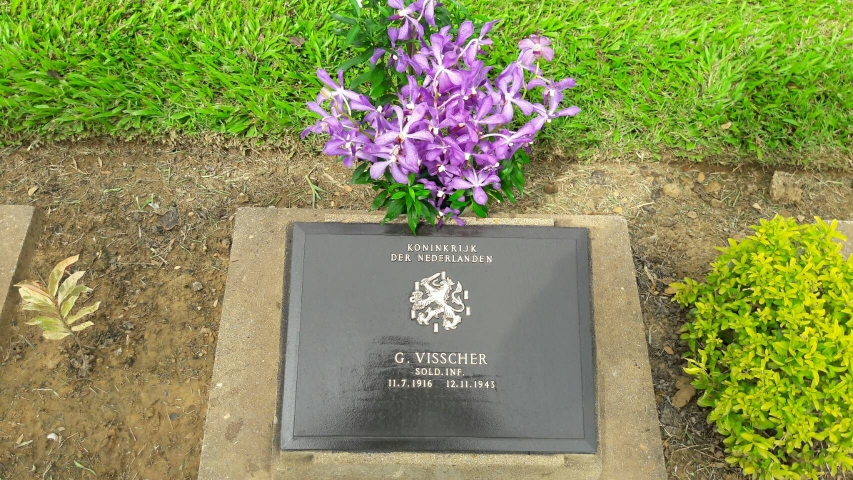
Grave of Gerrit Visscher. Photograph taken on July 11, 2018 at the Kanchanaburi War Cemetary in Thailand.
CALL
We have seen that there is given a reasonable picture of the route that has been taken and the circumstances. Personal information is not substantially. There are three pictures of Gerrit (in a KNIL uniform), one from 1936. There are no letters, ID-cards, memories or anecdotes known from his military time. Anybody who can add any details to the story about Gerrit Visscher, is kindly requested to contact the author.
Combat reports
Archival sources
National Archive, The Hague
NIOD, Institute for War, Holocaust and Genocide Studies, Amsterdam
Dutch Institute for Military History, NIMH
Foundation Administration Indonesian Pensions (SAIP), Heerlen
Red Cross
TBRC (Thailand-Burma Railway Centre), Kanchanaburi, Thailand
Internet:
www.japansekrijgsgevangenkampen.nl ("Japanese POW Camps", Henk Beekhuis)
www.kb.nl (Royal Library)
Thanks to:
Prof. Dr. P.H.M. Groen, co-author The Japanese Attack on Java, Dutch Institute for Military History, NIMH
Andrew Snow, Thailand-Burma Railway Centre, TBRC, Thailand
Henk Beekhuis
Museum Bronbeek, Arnhem